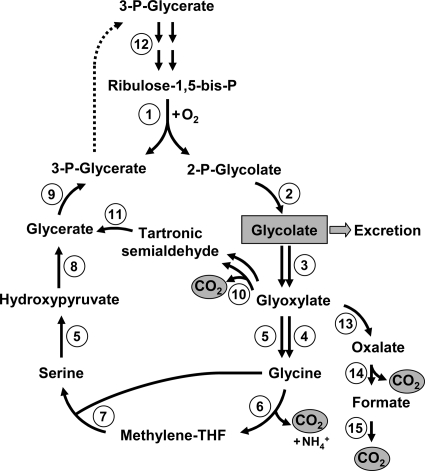FIG. 2.
Photorespiration. RubisCO-catalyzed oxygenation of ribulose-1,5-bisphosphate (enzyme 1) leads to the formation of 3-phosphoglycerate and 2-phosphoglycolate. 3-Phosphoglycerate returns to the CB cycle, whereas 2-phosphoglycolate is converted to glycolate by 2-phosphoglycolate phosphatase (enzyme 2). Glycolate can either be excreted or oxidized to glyoxylate by glycolate dehydrogenase or glycolate oxidase (enzyme 3). In the classical pathway functioning in, e.g., plants, glyoxylate is converted to glycine by glutamate-glyoxylate aminotransferase (enzyme 4) and serine-glyoxylate transaminase (enzyme 5). One molecule of glycine is then oxidized by the glycine decarboxylase complex (enzymes 6) to methylene-tetrahydrofolate (THF), which reacts with the second glycine molecule in the reaction, catalyzed by serine hydroxymethyltransferase (enzyme 7). The resulting serine is transaminated to hydroxypyruvate (enzyme 5) and then converted to 3-phosphoglycerate by hydroxypyruvate reductase (enzyme 8) and glycerate kinase (enzyme 9). An alternative pathway of glyoxylate assimilation is the condensation of two glyoxylate molecules giving rise to tartronic semialdehyde (glyoxylate carboligase [enzyme 10]). Tartronic semialdehyde reductase reaction (enzyme 11) leads to glycerate, and the latter is converted to 3-phosphoglycerate. Ribulose-1,5-bisphosphate regeneration proceeds via the CB cycle reactions (step 12). In some cases, glyoxylate can also be completely oxidized to CO2 in reactions catalyzed by hydroxyacid dehydrogenase (enzyme 13), oxalate decarboxylase (enzyme 14), and formate dehydrogenase (enzyme 15). All of these pathways can be found in cyanobacteria (27).

